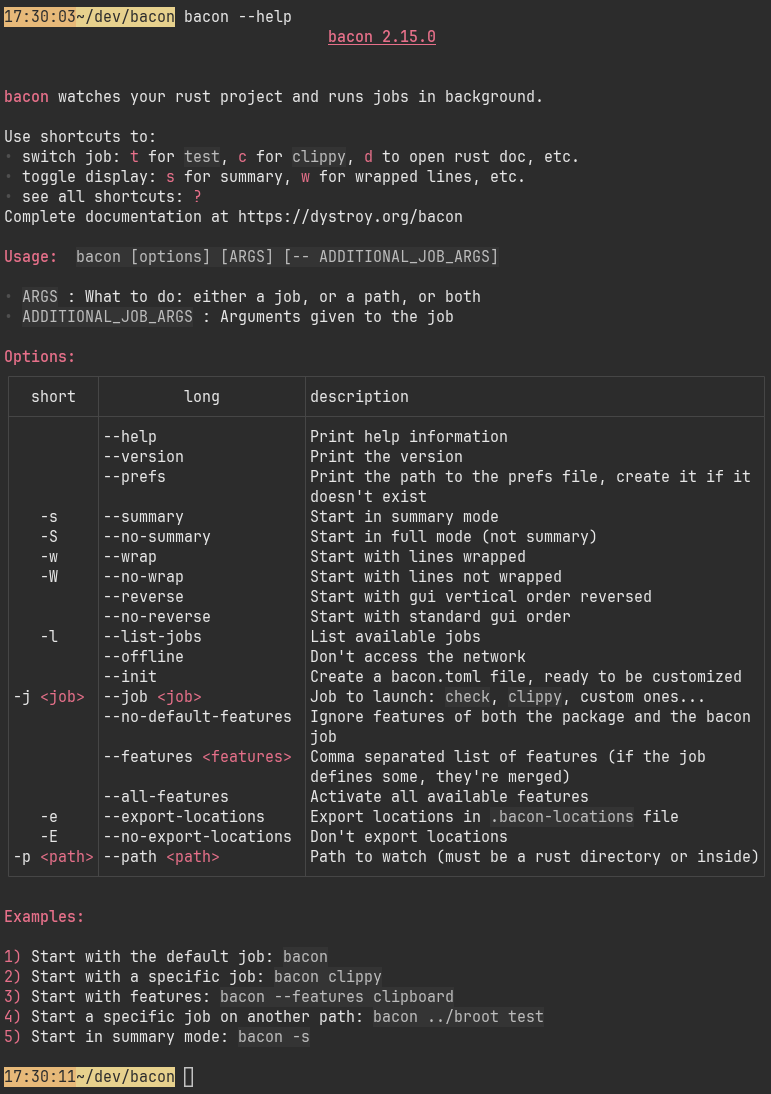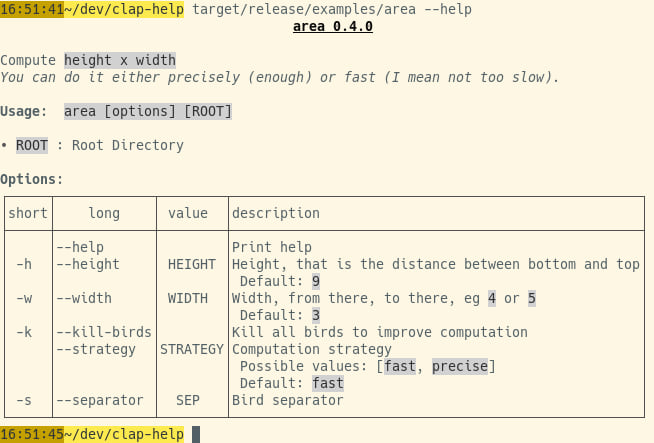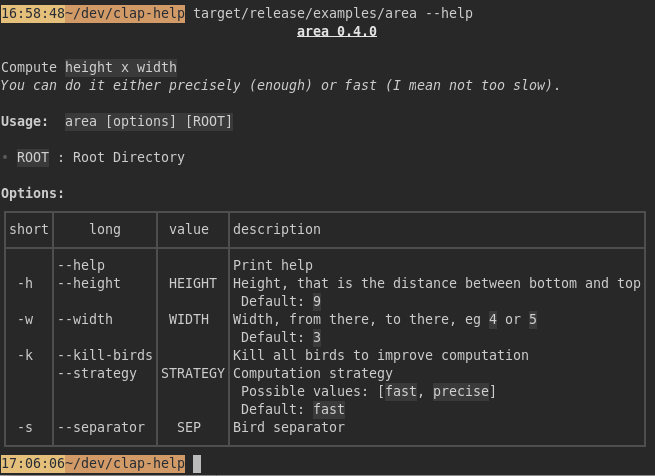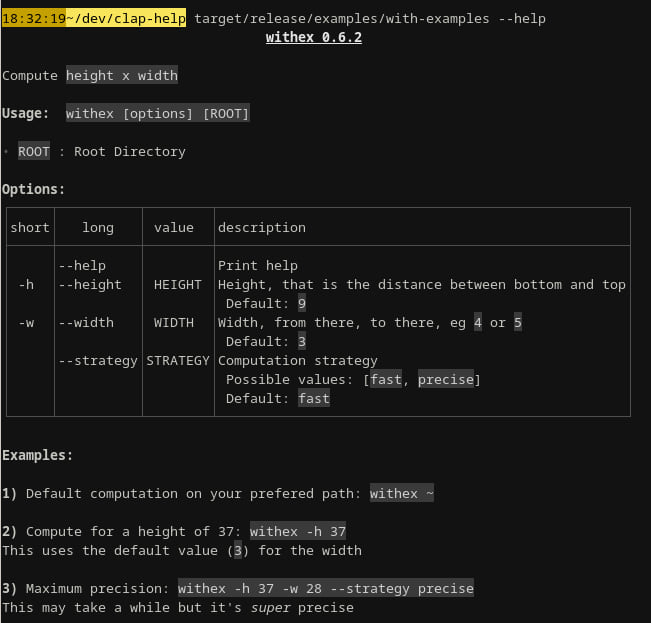20 releases (10 stable)
| 1.4.0 | May 9, 2025 |
|---|---|
| 1.3.2 | Feb 24, 2025 |
| 1.3.1 | Oct 26, 2024 |
| 1.2.0 | Mar 5, 2024 |
| 0.5.1 | Jul 20, 2023 |
#50 in Command-line interface
8,682 downloads per month
Used in 11 crates
(9 directly)
625KB
242 lines
clap-help
Purpose and Features
clap-help prints the --help message of clap based terminal applications.
Differences with the vanilla help renderer of the clap crate:
- more readable, thanks to a width aware layout
- more compact: from 2 to 3 times less lines compared to vanilla
- options rendered in a balanced table, optimized for the width of the terminal
- introduction interpreted as Markdown, allowing lists, tables, code blocks, etc.
- doc of options interpreted as Markdown
- skin automatically selected for light or dark terminals
- customizable termimad skin
- you can customize section templates, remove them, reorder them, add sections
Note: there's no support for subcommands yet.
Example
The bacon programs uses clap-help with an introduction text, a clearer options table, examples, and a skin consistent with the rest of the application:

How it's done: https://github.com/Canop/bacon/blob/main/src/args.rs.
Usage
Basic usage
Your program needs a clap Command defined.
Here's for example with clap-derive:
#[derive(Parser, Debug)]
#[command(name="area", author, version, about, disable_help_flag = true)]
struct Args {
/// Print help
#[arg(long)]
help: bool,
/// Height, that is the distance between bottom and top
#[arg(short, long, default_value = "9")]
height: u16,
/// Width, from there, to there, eg `4` or `5`
#[arg(short, long, default_value = "3")]
width: u16,
/// Kill all birds to improve computation
#[arg(short, long)]
kill_birds: bool,
/// Computation strategy
#[arg(long, default_value = "fast")]
strategy: Strategy,
/// Bird separator
#[arg(short, long, value_name = "SEP")]
separator: Option<String>,
/// Root Directory
pub root: Option<std::path::PathBuf>,
}
Notice
- the
disable_help_flag = truedisabling the standard behaviour of clap regarding help. - the explicit
helpargument. Here it's with only#[arg(long)]because-his used for something more important but you would most often have#[arg(short, long)].
The help introduction (the part before usage) is defined as a string which will be interpreted as Markdown. It can contain tables, lists, bold, italic, inline code, code blocks, etc.
static INTRO: &str = "
Compute `height x width`
*You can do it either precisely (enough) or fast (I mean not too slow)*.
";
On program launch, you should check the value of the help flag and, if necessary, print the help:
let args = Args::parse();
if args.help {
Printer::new(Args::command())
.with("introduction", INTRO)
.without("author")
.print_help();
return;
}
Help rendered in a light terminal:

Same help in a dark terminal:

Complete example is in /examples/area and can be seen with cargo run --example area -- --help
Adding custom sections
Help is usually easier to grasp with a few examples. You can write a few ones in your intro, or you can add them in a later section, after the options.
It's also possible to leverage the template system, which is what is done in the with-examples example, for this result:

Here's how it's done:
static EXAMPLES_TEMPLATE: &str = "
**Examples:**
${examples
**${example-number})** ${example-title}: `${example-cmd}`
${example-comments}
}
";
let mut printer = clap_help::Printer::new(Args::command())
.with("introduction", INTRO_TEMPLATE)
.without("author");
printer.template_keys_mut().push("examples");
printer.set_template("examples", EXAMPLES_TEMPLATE);
for (i, example) in EXAMPLES.iter().enumerate() {
printer
.expander_mut()
.sub("examples")
.set("example-number", i + 1)
.set("example-title", example.title)
.set("example-cmd", example.cmd)
.set_md("example-comments", example.comments);
}
printer.print_help();
Changing the skin
If your program has some kind of graphical identity, you may want to extend it to the help.
You may change colors, preferably with more compatible ansi color codes.
See example in examples/custom mainly features:

The strategy for those changes is
- to redefine the
bold,italic, andinline_codestyles to change their foreground color, to remove the background of the code, and to remove the Italic attribute ofitalic - to use the
TEMPLATE_OPTIONS_MERGED_VALUEtemplate for options
Here are the relevant parts of the code:
static INTRO: &str = "
Compute `height x width`
More info at *https://dystroy.org*
";
let mut printer = Printer::new(Args::command())
.without("author")
.with("introduction", INTRO)
.with("options", clap_help::TEMPLATE_OPTIONS_MERGED_VALUE);
let skin = printer.skin_mut();
skin.headers[0].compound_style.set_fg(ansi(202));
skin.bold.set_fg(ansi(202));
skin.italic = termimad::CompoundStyle::with_fg(ansi(45));
skin.inline_code = termimad::CompoundStyle::with_fg(ansi(223));
skin.table_border_chars = termimad::ROUNDED_TABLE_BORDER_CHARS;
printer.print_help();
Complete example is in /examples/custom and can be seen with cargo run --example custom -- --help
Please note that not every customization is possible or easy. And some may be easy but not obvious. Come to the chat and ask if needed.
Dependencies
~9–20MB
~296K SLoC